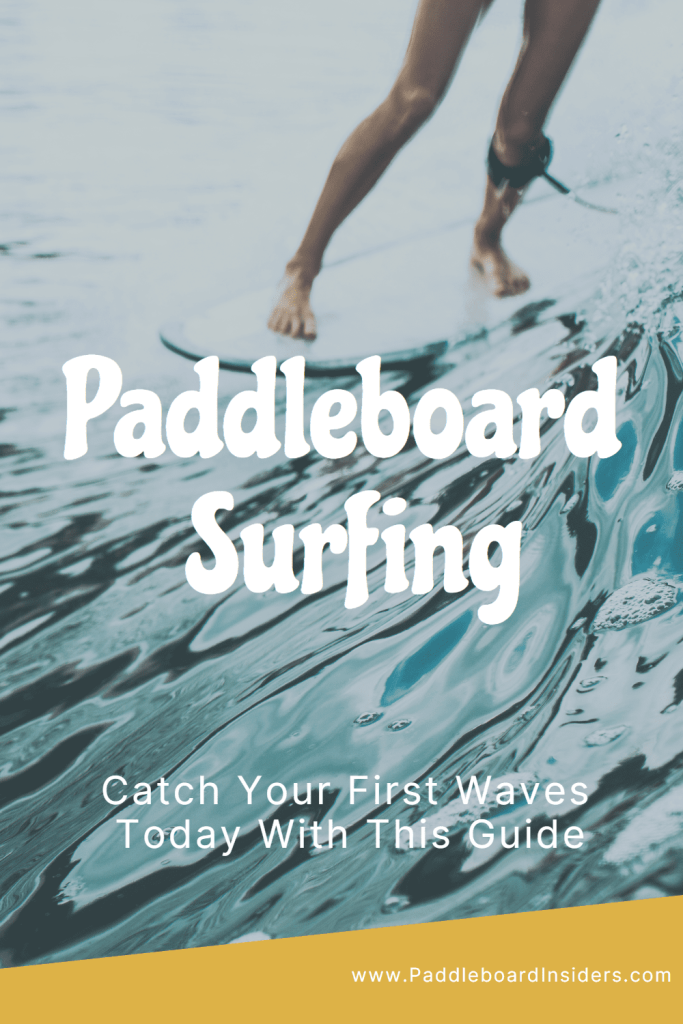Can You Surf On A Paddleboard? Yes – Here’s How To Catch Your First Waves Fast!
*We may earn a commission for purchases made using our links. Please see our disclosure to learn more.
If you’ve been thinking to yourself – “can you surf on a paddleboard?” Then let me tell you… Yes! You can!
And it’s really fun.
So if ou’re eager to start catching your first waves on your SUP, then you’ve come to the right place. In this article, I’ll guide you through the essential steps and techniques to help you conquer the art of wave riding.
Let’s jump in 🙂
| Looking for our best paddle board product recommendations? Check the Paddleboard Insiders Buyer Guides |
Table Of Contents
- Can You Surf On A Paddleboard?
- Why Learn to Catch Waves on a SUP?
- Essential Equipment for Catching Waves on a SUP
- SUP Board:
- Paddle:
- Leash:
- Personal Flotation Device (PFD):
- Choosing the Right Location
- Understanding Wave Types
- When Should You Catch The Wave?
- Mastering Paddling Techniques
- Positioning Yourself on the SUP
- Catching Your First Wave
- Maintaining Balance and Stability
- Falling Safely
- Common Mistakes to Avoid
- Tips for Progressing as a Wave Rider
- Conclusion: Can You Surf On A Paddleboard?
- FAQs
Can You Surf On A Paddleboard?
In case you didn’t know, stand up paddleboarding (SUP) is a water sport that involves standing on a large board while using a paddle to navigate through the water. You can do it anywhere that there is water so to answer your question, yes you can surf on a paddleboard 🙂
But why would you want to?
Why Learn to Catch Waves on a SUP?
There are several fantastic reasons to give wave riding a try. Firstly, wave riding on a SUP adds an extra element of excitement and challenge to your paddleboarding adventures. It’s an incredible way to test your skills, push your limits, and embrace the power of the ocean.
Secondly, catching waves on a SUP offers a unique perspective and a deeper connection with nature. Imagine gliding across the water’s surface, feeling the energy of the waves beneath you, and riding the rhythm of the ocean. It’s an experience like no other!
Essential Equipment for Catching Waves on a SUP
Before you hit the waves, it’s crucial to ensure you have the right equipment. Here’s what you’ll need:
SUP Board:
Opt for a shorter and more maneuverable board specifically designed for wave riding. The board’s shape and size play a significant role in your ability to catch and ride waves successfully.
My recommendation: Boardworks Kraken SUP
Where To Buy: Amazon
Key Features:
– Fiberglass
– Weight 29lbs
– Size 11′
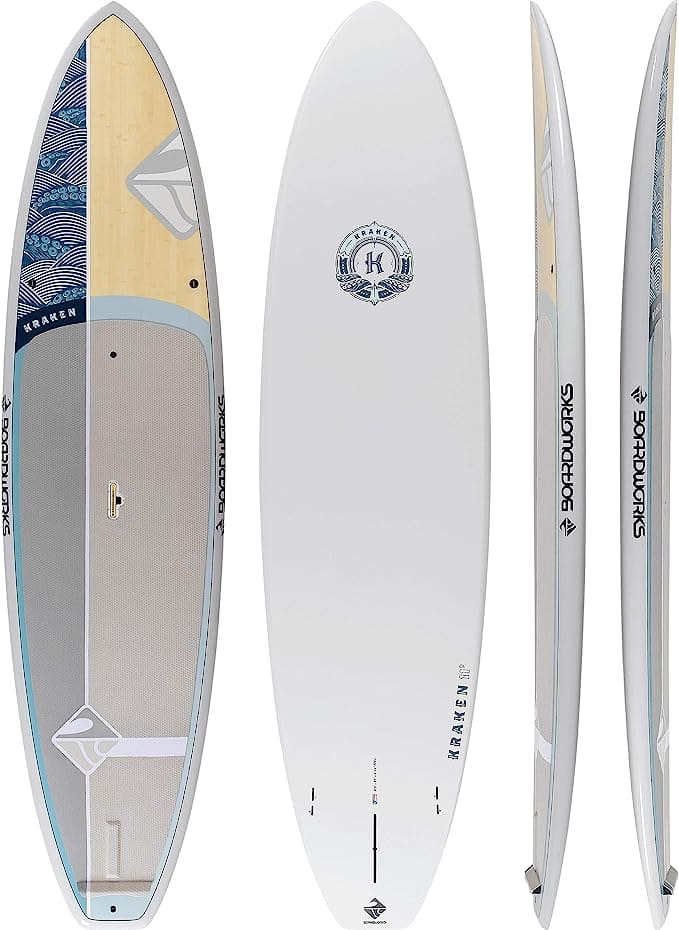
The Kraken is a versatile paddleboard that is a great option for riding waves. It has a wide stance for stability along with a sharp nose for dealing with the rough water. It is a little pricey but it is the #1 surfing SUP that I could recommend for you. Can you surf on a paddleboard? Yes – You definitely can on this one!
If you’d rather go with an inflatable paddleboard, then this might be a better option for you:
My recommendation: ISLE Explorer Paddleboard
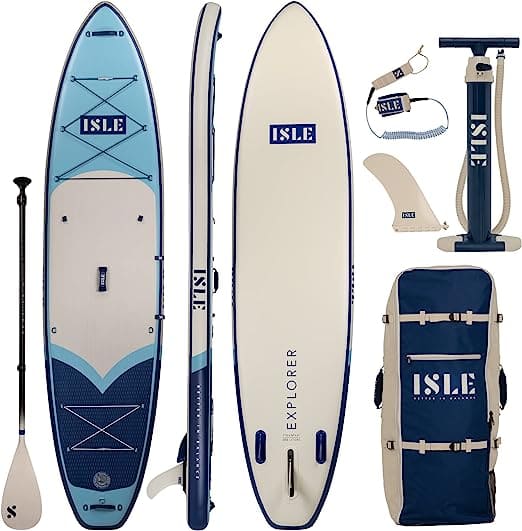
Where To Buy: Amazon
Key Features:
– Inflatable
– Weight 24lbs
– Size 11’6″
The ISLE Versa is a world class paddleboard that will be a great surfing SUP for you. It is a larger board (11’6″) that has a pointed nose for handling the choppy water in the sea and it also has smaller width to give you the maneuverability that you need on a wave. It’s a great choice to learn to surf on a paddleboard.
Paddle:
Choose a paddle that suits your height and provides the right amount of leverage. A quality paddle will enhance your stroke efficiency and help you maneuver with ease.
My recommendation: Super Paddles Elite 12k Bamboo
Where To Buy: Amazon
Key Features:
– 3 piece
– 12K Carbon Fiber
– 72 – 86 inch adjustable range
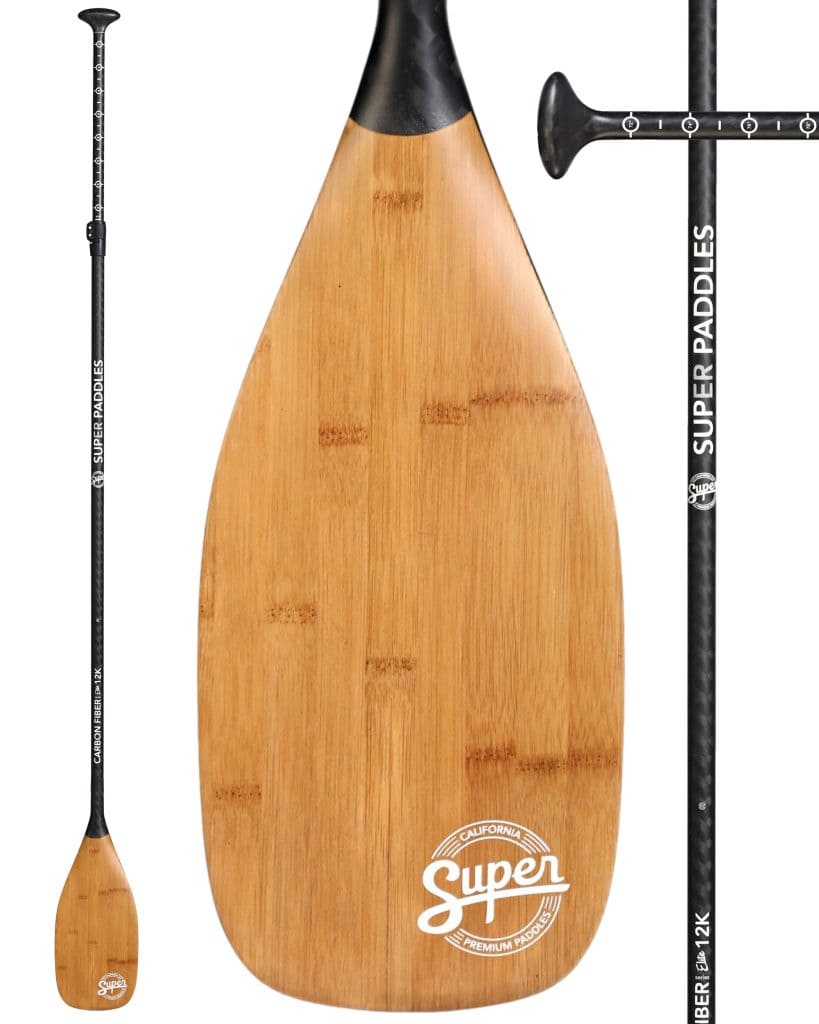
This is a featherlight paddle that packs a punch because you’ll be able to get some amazing speed & acceleration with it. Can you surf on a paddleboard? If you can catch the wave you can! This will help you do that.
Leash:
Always wear a leash to keep you connected to your board. It ensures your safety and prevents the board from drifting away if you fall. You want to make sure that you are using a coiled leash so that it doesn’t drag on the water or get caught in rocks (or a reef). That is really important!
My Recommendation: BPS ‘Storm’ Coiled Leash
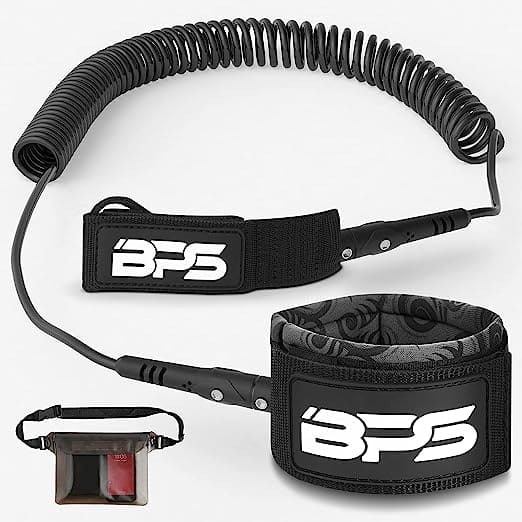
Where To Buy: Amazon
Key Features:
– Coiled leash
– Quick release tab
– 7.2mm cord
– 10 foot length
This is a really great coiled leash! When it comes to surfing the leash is really important because you don’t want to lose your SUP and you don’t want to get it hooked on things. That’s why this is my pick because it has a dual swivel and is coiled to prevent it tangling. Along with that it is high quality and cheap for what you get 🙂
Personal Flotation Device (PFD):
While not always mandatory, it’s highly recommended to wear a PFD for added safety, especially if you’re new to wave riding or venturing into more challenging conditions.
My recommendation: Onyx MoveVent Life Vest
Where To Buy: Amazon
Key Features:
– Style: Vest
– Weight: 1 pound
– USCG Rating: Type III
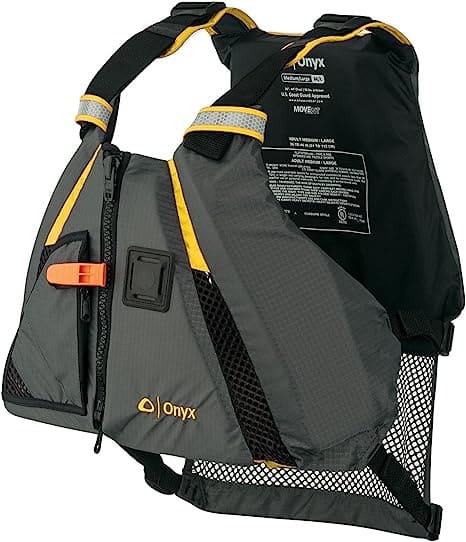
This is an awesome life jacket if you want to start surfing. It is extremely buoyant, comfortable and visible in the water (even in low light) and it will give you peace of mind that you’ll be safe if you ever take a tumble when riding on your first waves. Can you surf on a paddleboard? With this you can!
| Looking for more information? The Ultimate Guide To Surf SUP: Everything You Need To Know About Stand Up Paddle Boards For Surfing |
Now that you know what equipment you need, it’s time to choose the right location.
Choosing the Right Location
Selecting the right location is vital when it comes to catching waves on a SUP. Look for spots known for their beginner-friendly waves, with mellow breaks and a forgiving shoreline.
Research local surf spots, consult with experienced SUP surfers, and consider taking lessons from a qualified instructor. Familiarize yourself with the local rules and etiquette to ensure a respectful and enjoyable experience for everyone sharing the waves.
| You can also use this resource to try and find great paddleboarding locations along the coast: Best Places To Go Paddleboarding Near Me – A Free Interactive Guide |
Next you need to start understanding the different wave types.
Understanding Wave Types
To become a skilled wave rider, you must understand the different types of waves. Waves can vary in shape, size, and intensity, and each presents unique challenges and opportunities. Here are the primary wave types you’ll encounter:
Reform Waves: These waves break further from the shore and are usually gentler, making them ideal for beginners. Reform waves allow for longer rides and give you ample time to adjust and find your balance.
Beach Breaks: Beach breaks occur when waves break over a sandy seabed. They can be unpredictable but offer a mix of exciting peaks and gentle rides, making them suitable for progressing riders.
Point Breaks: Point breaks occur when waves break along a rocky or protruding point. They produce long, peeling waves that offer more extended rides, making them popular among experienced SUP surfers.
When Should You Catch The Wave?

You can see from the image above that you want to catch the wave at point (B).
If it’s too late then you will struggle to do anything on it with the large SUP. Can you surf on a paddleboard? If you catch it at the right time you can!
Mastering Paddling Techniques
Strong paddling techniques are fundamental to catching waves on a SUP. Follow these tips to hone your paddling skills:
| Powerful Strokes: | Engage your core muscles and use a combination of arm and torso rotation to generate power in your strokes. The stronger and more efficient your paddle strokes, the easier it will be to catch waves. |
| Timing: | Watch the waves and time your paddling to match the approaching swell. Paddle with purpose and increase your speed as the wave approaches to align yourself with its energy. |
| Maintain Momentum: | Once you’ve caught a wave, maintain a steady paddling rhythm to stay in the wave’s sweet spot. Consistent and controlled strokes will help you glide effortlessly along the wave face. |
Positioning Yourself on the SUP
Proper positioning on the SUP is crucial for catching waves effectively. Follow these guidelines:
Centered Stance:
Stand with your feet shoulder-width apart and keep your weight evenly distributed on the board. This balanced stance will give you better control and stability.
Forward Placement:
Position yourself slightly forward on the board, closer to the nose. This positioning helps the board cut through the water and prevents the nose from diving into the wave.
Catching Your First Wave
The moment has arrived – it’s time to catch your first wave on a SUP! Here’s a step-by-step process to guide you:
Step 1: Spot the Wave
Look for an approaching wave that suits your skill level. Choose a smaller, rolling wave that is not overly steep or fast.
Step 2: Paddle Strong
As the wave approaches, paddle with determination to match its speed. Focus on catching the momentum and aligning yourself with the wave’s energy.
Step 3: Feel the Glide
Once you feel the wave propelling you forward, transition from paddling to a controlled glide. Keep your body relaxed and your eyes focused on the direction you want to go.
Step 4: Maintain Balance
Find your balance by adjusting your weight and foot positioning. Keep your knees slightly bent and your gaze fixed on the horizon. This stability will help you stay upright on the moving wave.
Can you surf on a paddleboard? If you follow these instructions you can 🙂
Maintaining Balance and Stability
Maintaining balance and stability while riding waves on a SUP is crucial. Here are some tips to help you stay upright:
| Lower Center of Gravity: | Bend your knees slightly to lower your center of gravity, providing a more stable base. This position helps absorb the wave’s energy and reduces the risk of losing balance. |
| Constant Adjustments: | Continuously adjust your weight distribution and foot placement to adapt to the changing wave conditions. Small shifts in weight can make a significant difference in maintaining stability. |
These might sound a little tricky, but they always do until you’re out on the water. As soon as you get there it will feel natural.
Falling Safely
Falling is a natural part of learning to catch waves on a SUP. To ensure your safety and minimize the riskof injury, follow these guidelines for falling safely:
| Fall Away from Your Board | When you lose balance and feel yourself falling, try to fall away from your board. This prevents the board from hitting you and reduces the risk of getting injured. |
| Cover Your Head | As you fall, cover your head with your arms to protect it from any potential impact with the board or underwater obstacles. |
| Protect Your Feet: | If the water is shallow, keep your feet up to avoid hitting the ocean floor. Protecting your feet from potential injuries is crucial, especially in rocky areas. |
Common Mistakes to Avoid
As a beginner wave rider on a SUP, it’s essential to be aware of common mistakes and pitfalls. By avoiding these, you’ll progress faster and have a more enjoyable experience. Here are some mistakes to watch out for:
| Overcommitting | Don’t attempt to catch waves that are beyond your skill level. Start with smaller, manageable waves and gradually progress as your confidence and abilities increase. |
| Poor Wave Selection | Choosing the wrong waves can make catching and riding waves challenging. Avoid waves that are too fast, steep, or unpredictable until you have more experience. |
Tips for Progressing as a Wave Rider
Congratulations on catching your first waves on a SUP! As you continue on your wave riding journey, here are some tips to help you progress and refine your skills:
Practice Regularly:
Like any sport, consistent practice is key to improvement. Set aside dedicated time for SUP wave riding sessions and make it a part of your routine.
Observe Experienced Riders:
Watch experienced SUP surfers and learn from their techniques and wave-reading skills. Emulate their body movements and observe how they position themselves on the board.
Challenge Yourself:
Gradually challenge yourself by attempting waves of increasing difficulty. Push your boundaries, but always prioritize safety and respect the ocean’s power.
Conclusion: Can You Surf On A Paddleboard?
Catching your first waves on a SUP is an exhilarating experience that combines the thrill of wave riding with the freedom of stand up paddleboarding. By following the techniques and tips outlined in this article, you’ll be well on your way to becoming a confident and skilled wave rider. Remember, practice, patience, and respect for the ocean are key to your success. So grab your board, head to the beach, and embrace the joy of riding waves on a SUP!
| Looking for insider guides to some amazing paddle boarding locations? Check the Paddleboard Insiders Location Guides |
FAQs
How long does it take to learn to catch waves on a SUP?
The learning curve varies from person to person, but with consistent practice and dedication, you can expect to catch your first waves within a few weeks or months. Remember, progress comes with time, so be patient and enjoy the process.
Can I catch waves on any type of SUP board?
While it’s possible to catch waves on any SUP board, specialized wave riding boards are designed to optimize your experience. They offer better maneuverability, stability, and control in wave conditions, making it easier to catch and ride waves.
Is it necessary to wear a wetsuit while catching waves on a SUP?
Wearing a wetsuit depends on the water temperature and your personal preference. In colder conditions, a wetsuit provides insulation and protection from the elements. In warmer climates, you can opt for lighter alternatives like board shorts or rash guards.
What should I do if I wipeout?
Wipeouts are a common part of wave riding. If you find yourself in a wipeout, remember to stay calm, protect your head, and try to fall away from your board. Practice falling techniques and recovery maneuvers to increase your confidence and minimize the impact of wipeouts. They generally aren’t a big deal, so just try your best to enjoy the process of learning.
Can children learn to catch waves on a SUP?
Yes, children can learn to catch waves on a SUP, but it’s important to prioritize their safety and provide proper supervision. Start with smaller, gentle waves and ensure they have a comfortable and appropriately sized board. Consider enrolling them in SUP lessons tailored for kids to ensure they learn in a fun and safe environment.
